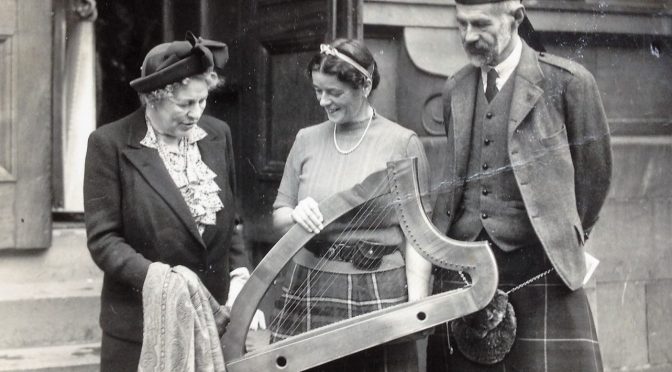I first became aware of Edith Taylor many years ago, from reading Frances Collinson’s book The traditional and national music of Scotland. After describing briefly the wire-strung clarsachs made by Arnold Dolmetsch, he writes:
Miss Edith Taylor, the first Honorary Secretary of Comunn na Clàrsaich, has one of these on which she once played for the writer at a B.B.C. ‘Country Magazine’ programme from Lochaline, Morvern.
Helene Witcher is the niece of Heloise Russell-Fergusson, another mid-20th-century Scottish harpist I have had a long interest in. I knew that Heloise had got the first clarsach that Dolmetsch had made, and last year Helene told me that she had located it. It was in the posession of an elderly lady, who had acquired it from Heloise in 1945, and who had then taken lessons from Edith Taylor, at Rahoy.

I was instantly intrigued by this story. Not only was there here a way to find information about Edith Taylor, but also apparently a previously unknown continuing tradition of playing wire-strung clarsach in Scotland through the second half of the 20th century.

This motivated me to search for information about Edith Taylor again. Nowadays, more and more old newspapers are being digitised, and so it was not hard to find out quite a bit about her from these sources.In 1927 she was teaching “physical culture” (a kind of aerobics exercise regime) in Perthshire schools. She played the harp to accompany a lecture about “Skye, Mull etc.” in Perth, in 1932, and in the same year she became Hon. Sec. of the newly-formed Clarsach Society. She was also a member of An Comunn Gaidhealach. She won second prize at the 1932 Mod for “best prepared original Gaelic speech”. Most years she donated generously to the Mod funds, typically one guinea (something like £200 in today’s terms). In December 1934, she played the harp in a Gaelic concert on the radio, and also gave a lecture on “the history of the clarsach and its music” to the Dundee Highland Society. From 1946 through to 1951 she entered the clarsach competitions at the Mod, and generally won first prize. From 1947 she ran an annual “School of harping” at Rahoy, on the far West coast of Scotland.
These newspaper mentions give us some insights into her character; her athleticism and energy organising the Society, her interest in harp history, and her musical ability.
One news story mentioned “at Rahoy, Mrs Newton and her friend, Miss Edith Taylor”… and so, having exhausted my search for Edith, I turned to Mrs Newton. At once I came across her genealogy, and got in touch with her descendents, who put me in touch with local historian Iain Thornber. They sent me some photographs of Edith and her “harp school”, showing her as a strong, handsome woman, sitting with her Dolmetsch harp on her left shoulder, in a group of women all playing modern gut-strung revival clarsachs. They also sent an article from Blackwoods Magazine, September 1973, by Dawn Macleod, who went to Rahoy in summer 1954. This literary memoir gave lots of personal information about Edith Taylor and Mrs Newton, including brief mentions of Edith’s harp playing and singing.
I asked Helene if it would be possible to meet the old lady, and so we went there together the other week. She had been about 10 years old in 1945, and she said that she had gone out to Rahoy for a couple of weeks each summer for just a few years. She had not heard of the 1947 “school of harping” which I found curious; her time there must have predated that. She explained how she could not read music, and she sat beside Edith, who would play, and then she would copy. She said how they played left hand high, right hand low, the other way round from everyone else, because that was the way it used to be done. She said they sounded the strings with long fingernails – I asked how long, and she seemed to think only 3mm or so. I asked her about how they tuned the harp, and she demonstrated some chord sequences and explained that they would always tune the harp in G major, with f sharps.
I asked what tunes they played; she mentioned “strathspeys and reels”, “Gaelic tunes”, such as “Kisimul’s Galley”, and “one or two ancient Irish tunes”. She seemed to have been most impressed with Edith’s collection of harp books; large, leather bound volumes with gilt titles, but she didn’t remember the contents. She said that Edith had written her a book of arrangements in some kind of tablature, but that it had fallen apart many years ago and she didn’t think she had any of it left any more.
She couldn’t tell me any more about Edith’s roots, where she got her harp from, or anything about where she came from. I think that this is where I need to concentrate my efforts now. Edith died in the spring of 1973, without any descendents.
My cover photo came via Helene Witcher and shows Edith (centre) with Heloise Russell-Fergusson (left) at Perth Mod in 1947.

Fascinating read. Thanks Simon!
Other tunes that Edith taught her young student were:
Bo lurach thu, a milking song (this was the first learned)
Maid of Morvern
Ee maro il yan bhara
McCrimmons Lament
Ee dat a duvil
Fir a bhata
Great article, dear Simon!
Thank you so much for working on the serious history.
Greets Jürgen